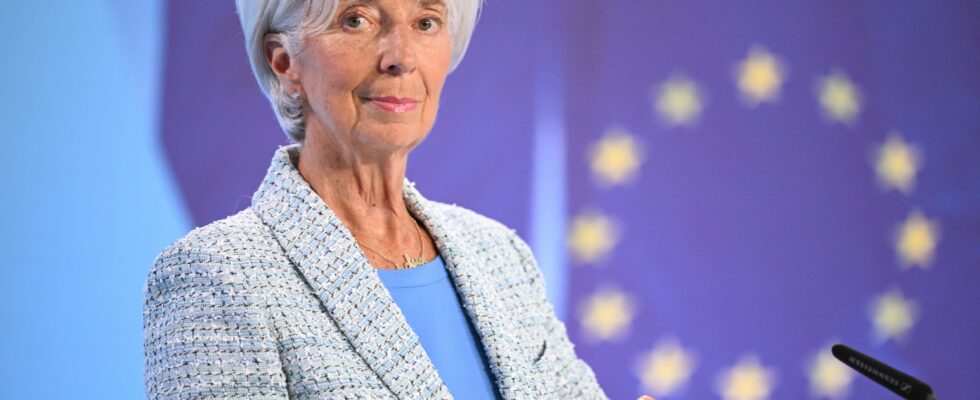It had already been three months since Christine Lagarde had prepared the ground. As expected, the European Central Bank (ECB) lowered its key rates by 0.25 points on Thursday June 6, a first since 2019. After ten successive increases since July 2022, the ECB changed course largely thanks to the decline in inflation in the euro zone.
The president of the monetary institution is now much more cautious about the future. A new meeting of the board of governors is due to take place next July, but everything suggests that the status quo should be favored. That of September, on the other hand, could be an opportunity to record a further decline, according to Nathalie Benatia, senior economist at BNP Paribas Asset Management. Everything will depend on the latest data available to the ECB at the end of the summer.
L’Express: Since July 2022, the ECB has made a habit of imitating the monetary policy of the American central bank (Fed). This time she took the lead, how can I explain it?
Nathalie Benatia: Saying that central banks copy from each other is not necessarily the best approach to understanding their decisions. Economic cycles are at very different points in the United States and the Eurozone. In the first case, we observed very solid growth, what we call a “output gap“, that is to say the growth accumulated above the trend which is positive and very important. In the second, we are coming out of a period of very weak growth. We came close to technical recession at several times.
This same output gap is negative in the euro zone with a slowdown in inflation on both sides of the Atlantic, which nevertheless remains above expectations. This nevertheless allows this first movement on rates to be made. There is still a difference between the Fed and the ECB: Jerome Powell [NDLR : président de la Fed] repeats that it is very data dependent. Christine Lagarde also says it, but ultimately, we have the impression that the European monetary institution has more confidence in inflation forecasts than its American counterpart.
Why is the Fed being more cautious?
It can wait given current growth in the United States. We must not forget that the electoral calendar in the United States, even if we are still a little far away, is getting closer. In the markets, people say that the Fed does nothing before an election. And in fact, it has never changed the direction of its monetary policy just before an election. Afterwards, since the emergence of Covid-19 we have been in a very particular cycle, it is not a rule written in stone.
What will be the first effects of the rate cut announced yesterday by the ECB on the economy?
This is the magic of monetary policy, we know that it does not act immediately. And 25 basis points of decline isn’t much. As Christine Lagarde pointed out, with a key rate at 3.75%, we are still in what is called a restrictive monetary policy.
After this primes the pump and this can have an impact on confidence. We saw an improvement in business surveys because they were expecting this drop. Furthermore, the savings rate is high in the euro zone. This is not necessarily precautionary saving, that is to say linked to fear of the future, but rather a postponement of consumption. In this configuration, this could support growth.
Christine Lagarde had already announced in April the loosening of monetary policy. The markets had anticipated this movement. How will they react now?
To my recollection, this is the first time that a cut has been so telegraphed by a central bank. Given the leaked material, this has irked some members of the board of governors. Everyone lined up though. If there had not been a drop yesterday, it would have shaken the markets a lot. The BCE would now like to avoid making such a firm commitment again for the future. Christine Lagarde did not give an indication of a date for a next reduction and spoke of the end of summer in order to have sufficient data. There was little expectation of a further cut by analysts for the next meeting in July, but they have clearly declined. The ECB is very likely trying to reframe expectations.
Christine Lagarde’s strategy, very affirmative for the first decline, very cautious from now on, surprises you?
This is probably some kind of compromise within the board of governors. It’s amazing. We forced the hand of what we call the hawks a little [NDLR : partisans d’une politique monétaire plus restrictive] and then we tried to give direction. Ultimately it was not necessarily worse in the current context, given the still volatile inflation data. Last Friday there was an upward surprise on inflation figures in the Eurozone: prices of services accelerated again. This figure, in the absence of this commitment, could have led the markets to say that nothing would happen on Thursday. This ultimately created a sort of anchor that was perhaps not so bad, unlike the US Federal Reserve. In the United States, expectations of a rate cut have been constantly postponed.
If the economic indicators are positive at the start of the school year in September, could the ECB decide to accelerate the downward movement?
You have to be humble when you are an economist. If central banks say they are dependent on data, we must say that we are too. There is currently no question of accelerating, according to estimates. A lot can happen. For the moment, the wisest would be to count once again on this rate of 0.25% in September and if all goes well, on a similar decline in December.
.
